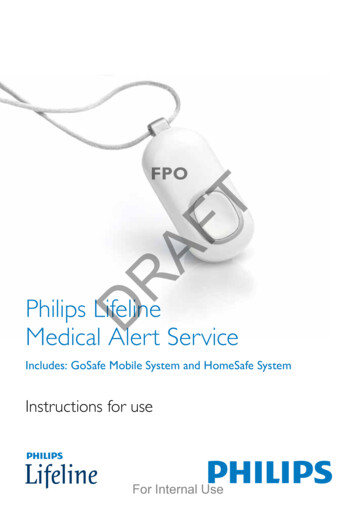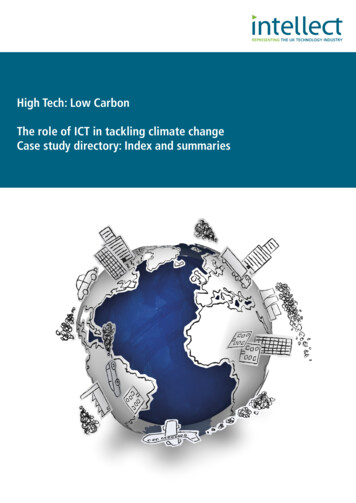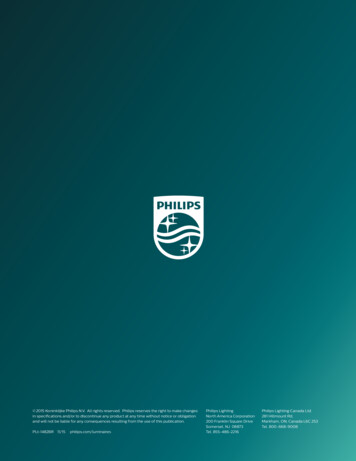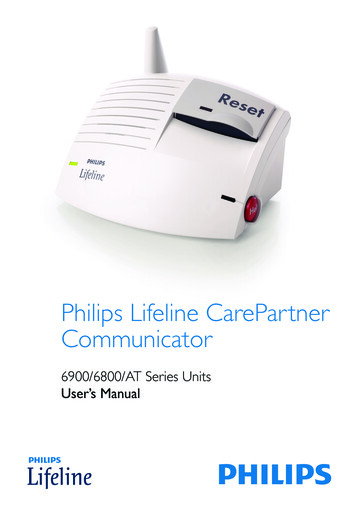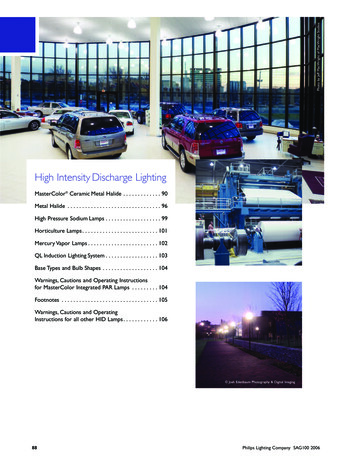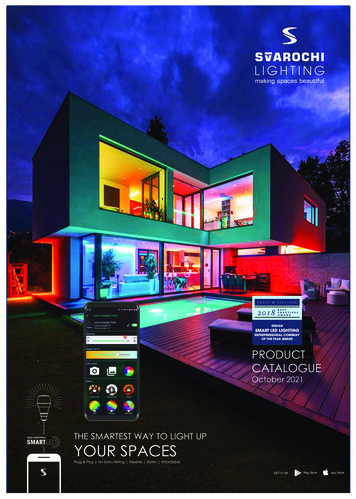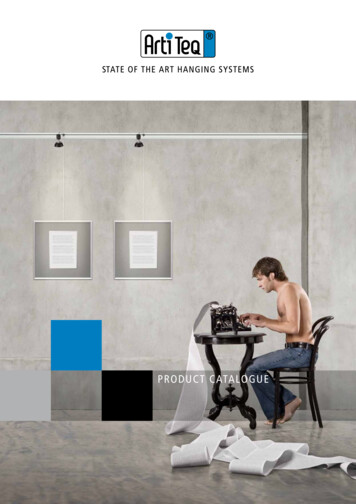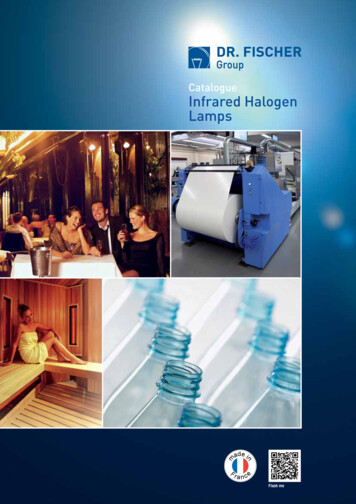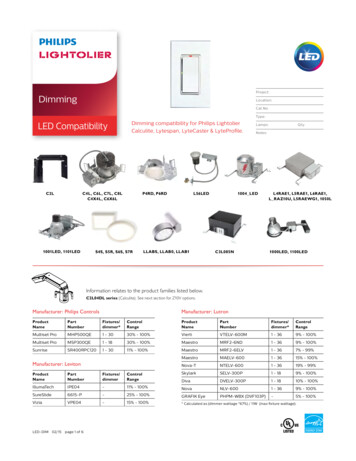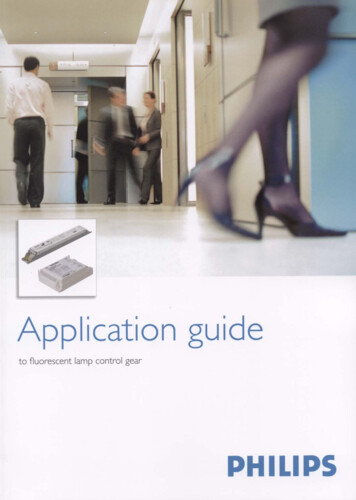
Transcription
1
ContentsContents .21 Introduction .61.1 Lamp families.61.2 Standards and quality: environmental aspects .71.3 Mains power supply voltage .101.4 Reliability, service life and warranty .111.5 Date and origin code .121.6 Developments in lamp control gear .142 General aspects .152.1 Main ballast functions .152.2 Luminaire classifications .152.2.1 Electrical safety (four luminaire classes) .152.2.2 Dust and moisture protection (IP classification) .162.2.3 Degree of flammability of the mounting surface.172.3 Electromagnetic compatibility (EMC) .172.3.1 General.172.3.2 Influence on other electrical or electronic equipment .192.3.3 Regulations .212.3.4 Luminaire design .232.4 The Energy Efficiency Index .263 Lamps .273.1 Range .273.2 Stabilisation.293.3 Ignition and run-up .303.4 Lamp behaviour as a function of the frequency.323.6 Effects of temperature .343.7 Optimum operation.363.8 Lamp life and depreciation .373.9 Influence of switching cycle .383.10 Stroboscopic effect and striations .393.11 Dimming .404 Electronic lamp control gear.414.1 Electronic high-frequency system .414.1.1 Block diagram (see Fig. 43) .414.1.2 Circuit diagram (see Fig. 44).414.1.3 Choice of frequency .424.1.4 Ignition and re-ignition .424.1.5 Ballast types .444.1.6 Cut-off principle .444.1.7 Harmonic distortion .454.1.8 Power factor .474.1.9 Inrush current .484.1.10 Circuit breakers and fusing .494.1.11 Earth leakage .502
4.1.12 Electrical connections .504.1.13 Internal and external cabling .504.1.14 Lifetime .514.1.15 Effects of mains voltage fluctuations .534.1.16 Ambient and operating temperatures .544.1.17 Earthing .554.1.18 Fault finding .564.1.19 Installation aspects .604.2 Light regulation with HF ballasts .644.2.1 General: block and circuit diagrams .644.2.2 The dimming process.654.2.3 Ignition and re-ignition .654.2.4 Ballast types .654.2.5 Harmonic distortion .654.2.6 Power factor .664.2.7 Electromagnetic compatibility (EMC) .664.2.8 Starting and operating temperature.664.2.9 Input voltage versus light output with analogue ballasts .674.2.10 The digital DALI (Digital Addressable Lighting Interface) ballast.684.2.11 The Touch and Dim Ballast .724.2.12 Installation aspects .734.3 Control possibilities .734.3.1 Luminaire-based controllers .744.3.2 Room-based solutions .764.3.3 Lighting Management Systems (for complete buildings).774.3.4 General-purpose products .784.3.6 Installation aspects.784.4 Electronic ballasts for DC supply voltages.784.4.1 Introduction .784.4.2 Special lamps .784.4.3 Emergency lighting: definitions and standards .794.4.4 Emergency lighting systems .804.4.5 The standard and regulating HF ballast with standard lamps .825 Electromagnetic lamp control gear .845.1 Ballasts .845.1.1 Main ballast functions .845.1.2 Stabilisation.845.1.3 Ignition and re-ignition .845.1.4 Types of ballasts.855.1.5 Ballast specification and marking .865.1.6 Maximum coil temperature tw and ΔT.865.1.7 Watt losses .875.2 Starters .885.2.1 Main starter functions .885.2.2 Starter types .885.2.3 Lifetime .895.3 Systems .893
5.3.1 Components .895.3.2 Capacitors.905.3.3 Filter coils .915.3.4 Power factor correction .925.3.5 Series connection of lamps .955.3.6 Neutral interruption and resonance .955.3.7 Electrical diagrams .975.3.8 Mains voltage interruptions and short-circuiting .985.3.9 Harmonic distortion .985.3.10 Electromagnetic interference .1005.3.11 Lifetime .1005.3.12 Ambient and operating temperatures .1015.3.13 Effects of mains voltage fluctuations .1045.3.14 Electrical wiring .1045.3.15 Hum .1055.3.16 Dimming .1065.3.17 Stroboscopic effect and striations .1075.3.18 Circuit breakers, fusing and earth leakage .1095.3.19 Fault finding .1125.3.20 Installation aspects .1155.3.21 Non-standard supply voltages .1155.3.22 Maintenance .1164
5
1 IntroductionWe are living in a rapidly changing world, andtechnological developments play an important partin this. Also in the world of lighting, new products andapplications are launched all the time in order to give thebest solution for the changing demands of the customers.Issues like better colour properties, lower powerconsumption, smaller dimensions, longer lifetime, lowercosts, more flexibility, are the basis for modern lightingsystems. New or improved lamp types and luminaires canbe an adequate answer to the changing demands.But the heart of any lighting system still is and willcontinue to be the lamp and its control gear. The lampcircuits have to answer to numerous basic needs,including compliance with national and internationalsafety standards, ease of installation, compatibility and, ofcourse, price/performance ratio.This Guide deals with control gear for the Low-PressureMercury lamps, as indicated in the grey area.A second guide deals with the HID (Sodium and Highpressure Mercury) circuits.Both guides are divided into two parts:- conventional gear, comprising electromagnetic ballasts,ignitors (starters) and capacitors- electronic ballasts and controllersIn this Guide, some information about Controlpossibilities (controllers/sensors, 1-10V, DALI and Touchand Dim) is also included.This Guide provides information on those aspectsof lamp control gear that is needed to acquireunderstanding of the total lighting system. Togetherwith the publications on the Internet and the variousproduct data sheets it forms a set of information thatwill hopefully provide answers to all practical questions.Knowledge of all ins and outs enables designers, installers,OEMs and end-users to make a good choice whenlooking for the best possible lamp control gear.Related Internet sites:For the home site of Philips Lighting:http://www.lighting.philips.com1.1 Lamp familiesFollowing the main principle of operation, the family ofelectric light sources can be sub-divided as SOLID STATEHALOGENHIGH POWER LOW -SMLHPHPIMHNMHWMHDCDMCDOCPO-TWSOXSONSDWCPO-TG6
Following the Philips nomenclature this guide deals with:The range of ‘TL’ lamps is much wider than the typesmentioned in the table, which contains only the more orless ‘standard’ types. There are many more versions(‘TL’ F/X/R/RS/MRS/A) and other lamp powers.Information on the various types and the related gear canbe supplied by the local Philips Lighting organisation.Gear for the Retrofit lamps (like PL*E family) is notmentioned in the table, since with these lamps the gear isincorporated in the lamps themselves.ELECTROMAGNETICWATTAGE BALLASTLAMP‘TL’ miniature 4-13BTL‘TL’-DBTA18-58STARTERELECTRONICS2, S10HF-MS2, S10e-Kyoto, HF-M,S2E, S10EHF-B, HF-P, HF-R,SiS10HF-R DALIS16HF-P-HF-M, HF-P, HF-R,HF-R T36-5870‘TL’5 HE14-35-1.2 Standards and quality: environmental aspectsDesigners, contractors and installers are regularlyconfronted with a great variety of standards andrecommendations in the field of lighting, and lamp controlgear is by no means an exception in this respect. Whatmakes things even more complicated is the fact that suchstandards and regulations often differ from country tocountry.To start with, international worldwide electrical standardsfor lighting have been laid down by the IEC (InternationalElectrotechnical Commission). There is, for example, anIEC standard for tubular fluorescent lamps for generallighting purposes: IEC 60081.This standard specifies:- lamp electrical characteristics,- reference ballast characteristics,- lamp starting test,- lamp dimensions,- further information on ballast, ignitor and luminairedesign.HF-R DALI, HF-R T‘TL’5 HO24-54--80--HF-P, HF-R,HF-R DALI, HF-R THF-P, HF-R,HF-R DALI‘TL’5 C22-60--HF-M, HF-P, HF-R‘TL’ E, ‘TL’ U20-65BTAS10, S10E-PL-S 2 pin5-11BPL--PL-S 4 pin5-11BPLS2, S10HF-MHF-R DALI, HF-R TPL-C 2 pin8-26BTL, BPL, BTA -PL-C 4pin10-26BTLS2, S1010-13HF-M10-26HF-PHF-R, HF-R DALI18-26PL-L-18-36BTAS2, S10-S2E, S10ESiS1018-24--36-55--HF-M, HF-PHF-B, HF-P, HF-RHF-R DALI55--HF-RTPL-T 2 pin18-26BPL, BTA--PL-T 4 pin18-57BPL, BTASiS10,HF-M, HF-P, HF-R,S2, S10,HF-R DALI, HF-R TNot all types within a lamp family are standardised andfor some new lamp types there are as yet no standardsat all.Apart from these worldwide standards there areequivalent European standards as laid down by CENELECfor the EU countries. The home page of CENELEC canbe found on: http://www.cenelec.org/S2E, S10EPL-H60-120PLQ 2 pin16-28PLQ 4 pin16-38--HF-PExplanation of the abbreviations:BPL Ballast PLBTL Ballast ‘TL’ miniatureBTA Ballast ‘TL’(D)HF-B High-frequency - BasicHF-P High-frequency - PerformerHF-R High-frequency - RegulatorHF-M High-frequency - Matchboxe-Kyoto electronic - Kyoto7
For fluorescent lamps and control gear relevant IEC andEN standards are:- lamp caps and holders:IEC 60061- ballasts for tubular fluorescent lamps (50/60Hz)EN 60920 / 60921- starters for tubular fluorescent lamps:IEC 60155- capacitors for discharge lamp circuits:IEC 61048 / 61049- starting devices (other than glow starters):IEC 60926 / 60927- AC supplied electronic ballasts for tubular fluorescent lamps:IEC 61347 / 60929- tubular fluorescent lamps for general lighting purposes:IEC 60081- single-capped fluorescent lamps (PL):IEC 61199/60901- DC supplied electronic ballasts for tubular fluorescent lampsIEC 60924 / 60925- self-ballasted lamps for general lighting services (SL):IEC 60968/60969As control gear is often built into a luminaire, the most important IEC standard in this respect is:IEC 60598EMC requirements ( 30 MHz) have been laid down in:EN 55015EMC requirements (30 to 1000 MHz) have been laid down in:EN 55022A or BThe standards are often split up into a Safety and aPerformance edition. The Safety edition deals withaspects for operation without danger to the user or thesurrounding, while the Performance edition deals withissues as guarantee for ballast/lamp interchange ability,satisfactory starting and operation and the like.Copies can be ordered via the IEC Internet address:http://iec.ch/A set of IEC Standards has been edited.The set forms the “Omnibus Standard” for Lamp ControlGear.The standards are:- IEC 61347-1General and safety requirements- IEC 61347-2-1Particular requirements for starting devices (other than glow starters)- IEC 61347-2-2Particular requirements for d.c. or a.c. supplied electronic step-down converters for filament lamps- IEC 61347-2-3Particular requirements for a.c. supplied electronic ballasts for fluorescent lamps- IEC 61347-2-4Particular requirements for d.c. supplied electronic ballasts for general lighting- IEC 61347-2-5Particular requirements for d.c. supplied electronic ballasts for public transport lighting- IEC 61347-2-6Particular requirements for d.c. supplied electronic ballasts for aircraft lighting- IEC 61347-2-7Particular requirements for d.c. supplied electronic ballasts for emergency lighting- IEC 61347-2-8Particular requirements for ballasts for fluorescent lamps- IEC 61347-2-9Particular requirements for ballasts for discharge lamps (excluding fluorescent lamps)- IEC 61347-2-10Particular requirements for electronic invertors and convertors for high-frequency operation of cold start tubular discharge lamps (neon tubes)8
well as the ISO 9001 certificate. ENEC is mainly relatedto performance aspects.The number in the ENEC marking indicates the testhouse which gave the approval:This set of IEC Standards will replace the safety standards:IEC (60)920, (60)922, (60)924,(60)926, (60)928 and(6)1046. In general the contents of this first edition ofthe “omnibus” is the same as the contents of the “old”standards.For IEC the “old” standards remain valid until they arewithdrawn, but they will vanish from the list of standardsthat can be bought.For CENELEC there will be definite dates for the validityof the “old” standards.Amendments and new items will be incorporated in the“omnibus” only from now on.Note: The performance standards are not affected.CE is the abbreviation of ‘Conformité Européenne’. Itstates conformity of products to the most essentialre
- lamp electrical characteristics, - reference ballast characteristics, - lamp starting test, - lamp dimensions, - further information on ballast, ignitor and luminaire design. Not all types within a lamp family are standardised and for some new lamp types there are as yet no standar
